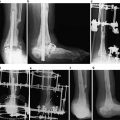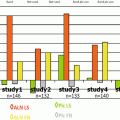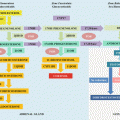Drug
Mechanism
Inhibition of thyroid hormone synthesis and secretion
Amiodarone
Inhibits type I and type II 5′ deiodinase, leading to decreased T3 generation from T4
Iodinated contrast agents
Inhibit type I and type II 5′ deiodinase, leading to decreased T3 generation from T4
Decrease hepatic uptake of T4
Inhibit T3 binding to its nuclear receptor
Thiocyanate, perchlorate
Inhibit iodide transport into the thyroid gland
Propylthiouracil, methimazole
Inhibit thyroid peroxidase; propylthiouracil additionally inhibits peripheral conversion of T4 to T3
Lithium
Inhibits iodide binding and thyroid hormone release
Decreased absorption of exogenous thyroid hormone
Calcium compounds, sucralfate, aluminum hydroxide, ferrous compounds, cholestyramine, colesevelam, proton-pump inhibitors, H2 blockers
Bind to levothyroxine and reduce its absorption
Increased T4 clearance
Rifampin
Induces hepatic microsomal enzymes
Phenobarbital, carbamazepine
Induce hepatic microsomal enzymes
Compete with thyroid hormone binding to TBG
Accelerate the conjugation and hepatic clearance of T4/T3
Decreased TSH secretion
Dopamine, l-Dopa, bromocriptine
Increase T3 synthesis from T4 in the brain
Opiates
Block the breakdown of T3 in the brain
Others
Estrogens, SERMs
Increase thyroid-binding globulin
Steroids
Influenced by dose, type, and route of administration of glucocorticoid. Inhibit deiodination of T4; suppress TSH secretion; increase in renal iodide clearance
Salicylates
Compete for thyroid hormone-binding sites on binding proteins
Thalidomide
Immune-mediated subacute destructive thyroiditis
Medications that cause a reduction in TSH secretion, such as glucocorticoids, opiates, and dopamine agonists, are also implicated in causing hypothyroidism.
Worldwide, the most common cause of primary hypothyroidism is iodine deficiency with approximately two billion people at risk, particularly those living in mountainous areas due to persistent glacial runoff depleting iodine stores. Consumption of cassava which contains compounds metabolized to thiocyanate enhances the iodine-deficient state by inhibiting thyroid iodine transport. The World Health Organization and the US Food and Drug Administration recommendations are a daily iodine intake of 150 μg/day for the general adult population and 200 μg/day for pregnant or lactating women.
Other forms of thyroiditis may also cause primary hypothyroidism. Subacute or granulomatous thyroiditis initially presents with neck pain and biochemical hyperthyroidism, and may be followed by hypothyroidism. In one study, about 10 % of patients developed permanent hypothyroidism, defined as an elevation in TSH lasting beyond 1 year [10]. Postpartum thyroiditis (PPT) may present with hyperthyroidism followed by transient hypothyroidism, hyperthyroidism alone, or hypothyroidism alone in about 50 % of cases, usually within 2–6 months after delivery. It is more common in women with TPO antibodies, which confers up to a 50 % chance of developing PPT [11]. Most patients are euthyroid within the first postpartum year, although permanent hypothyroidism is more likely to develop in women with higher TSH values and higher antibody titers [12].
Iatrogenic causes such as post-thyroidectomy or post-ablative hypothyroidism constitute another category of primary hypothyroidism. Hypothyroidism occurs within 2–4 weeks of total thyroidectomy owing to thyroxine’s half-life of 7 days. Data from patients undergoing radioactive iodine therapy for Graves’ disease indicate that the rate of subsequent hypothyroidism is largely dependent on the dose of radioiodine used; in the United States most patients are hypothyroid within the first year of treatment [13]. External beam radiation which exceeds 25 Gy also causes hypothyroidism, which may be gradual in onset.
Infiltrative processes including hemochromatosis, lymphoma, amyloidosis, and sarcoidosis are rare causes of primary hypothyroidism. They tend to present as progressive, painless bilateral enlargement of the thyroid gland, and are usually part of more widespread systemic involvement of the disease. Infection of the thyroid is rare as the gland is encapsulated, and has good blood flow and a high iodine content. However Pneumocystis jiroveci infection in immune-compromised patients has been reported to cause enough destruction of the thyroid gland leading to inadequate thyroid hormone production [14].
Consumptive hypothyroidism is a rare disorder that was initially identified in infants with visceral hemangiomas. There is a marked elevation in deiodinase type 3 (D3) activity which results in the conversion of T4 to reverse T3 and T3 to T2. The condition is treatable medically with glucocorticoids and interferon α.
Congenital hypothyroidism affects 1:6,000 live births in the United States [15]. Infants with the disorder have little to no clinical features of hypothyroidism and they are detected largely through newborn screening programs in place since the 1970s. Thyroid dysgenesis is responsible for 85 % of cases, with the remaining being caused by defects in thyroid hormone production at every level. Worldwide, the commonest cause is thyroid ectopy which accounts for about two-thirds of patients with thyroid dysgenesis. Central congenital hypothyroidism is much rarer and may be missed by screening programs that utilize TSH only. These infants usually have other pituitary hormone deficiencies [16]. Transient hypothyroidism in infants can occur as a result of maternal iodine insufficiency, maternal TSH receptor-blocking antibodies, or exposure to antithyroid drugs; infants are rendered euthyroid once the offending agent (antibody or drug) is naturally cleared.
Central (Secondary and Tertiary) Hypothyroidism
Central hypothyroidism is caused by TSH deficiency from disorders of the pituitary gland or hypothalamus. It is usually accompanied by deficiencies of other pituitary hormones, and can vary in severity. About 15 % of the function of the thyroid gland is independent of TSH and therefore central hypothyroidism may be milder clinically than primary hypothyroidism. Central hypothyroidism may be caused by tumors, surgery, and infiltrative, inflammatory, or infective processes and medications.
Generalized Thyroid Hormone Resistance
Thyroid hormone resistance is a rare, autosomal dominant disorder in which the majority of patients have a mutation in the TR-beta gene. This results in reduced T3-binding affinity at the level of the thyroid hormone receptor and a reduced response to T3. Two-thirds of patients have goiters, but their symptoms may be a mix of both hypo- and hyperthyroid complaints. There is an increased prevalence of attention-deficit disorder which is present in about 10 % of patients [17]. Laboratory testing shows an elevated free thyroxine with normal or slightly increased TSH levels—the disorder therefore has to be differentiated from a TSH—secreting pituitary tumor. Treatment with T4 or T3 may be beneficial in patients with symptoms of hypothyroidism.
Physical Examination
Physical signs of hypothyroidism are notoriously nonspecific and vary according to the severity of the disorder. The use of sensitive thyroid assays has largely superseded the value of physical examination findings in making the diagnosis of thyroid dysfunction (Table 3.2).
Table 3.2
Common physical examination findings in hypothyroidism
Skin | Puffiness of the periorbital tissues, hands and feet, and supraclavicular fossae secondary to myxedema, pallor from anemia, dry, coarse skin secondary to reduced sebaceous gland secretions, easy bruising, dry brittle hair and nails |
Cardiovascular | Narrow pulse pressure, reduction in cutaneous blood flow leading to cool, pale skin, distant heart sounds (if pericardial effusion is present) |
Gastrointestinal | Weight gain from fluid retention, abdominal gaseous distension (myxedema ileus) |
Nervous system | Slowing of higher mental function including speech, slowing of the relaxation phase of tendon reflexes |
Muscular | Slightly increased muscle mass due to interstitial myxedema, myoclonus |
Evaluation
Laboratory testing is essential for making the diagnosis of hypothyroidism due to the lack of sensitivity and specificity of clinical findings. The most sensitive, “gold standard” test is TSH using a third-generation chemiluminescent immunoassay, which has the advantage of being more sensitive at the lower range than the second-generation test. The free thyroxine (FT4) level will differentiate between overt and SCH. Equilibrium dialysis is the gold standard for the measurement of FT4; however direct measurement via ultrafiltration is the most widely used method. It can also be measured indirectly through the free thyroxine index (FT4 index). Total thyroxine levels are affected by conditions that increase binding protein (e.g., pregnancy and illness) and must therefore be interpreted with caution.
There is considerable debate about the upper limit of normal for the TSH reference range. Data from the NHANES studies has shown an age-specific distribution of TSH, with higher normal values being seen in the elderly [18]. This has led some groups to propose a lowering of the upper limit of normal particularly in younger individuals, but evidence that thyroid hormone replacement in this newly identified group is beneficial is mixed [19]. Controversy also continues regarding the benefits of thyroxine therapy in SCH, with some recommending treatment [20, 21] and others arguing against replacement therapy, particularly in the elderly [22].
The measurement of TPO antibodies may be helpful in determining the etiology of hypothyroidism or in predicting the likelihood of progression to overt hypothyroidism in patients with SCH.
Patients with hypothyroidism may have associated laboratory findings including an elevated creatinine kinase, hyponatremia, and elevated total and LDL cholesterol values.
Ultrasound of the thyroid gland is not routinely recommended, but may be useful to confirm the diagnosis of Hashimoto’s thyroiditis if the characteristic heterogeneous echotexture is seen.
Treatment
Treatment of hypothyroidism is with thyroid hormone replacement, and the goal of therapy is to restore both biochemical and clinical euthyroidism. Levothyroxine (LT4) is the preferred agent as it allows for prevalent physiologic mechanisms to maintain T3 production in peripheral tissues. It has a half-life of 7 days, and therefore dose titration should be done after about 6 weeks once equilibration is achieved. A TSH goal should be used to adjust the dose of therapy, except in patients without an intact hypothalamic-pituitary-thyroid axis, in which case FT4 is used. Patients with suspected glucocorticoid deficiency should be evaluated and treated prior to initiation of levothyroxine.
The typical daily dose of levothyroxine in a patient without endogenous thyroid function is about 1.6 μg/kg ideal body weight. Care should be taken when initiating treatment in elderly patients with angina, as thyroid hormone can increase myocardial oxygen demand. Therefore, a recommended starting dose of between 25 and 50 μg/day is preferred with titration by 12.5–25 μg every few weeks in this population. Patients with SCH also require a lower starting dose of levothyroxine.
Levothyroxine should be taken on an empty stomach, ideally separated from food by at least 1 h. Several medications may affect the absorption of thyroid hormone (Table 3.1), and patients should be educated to allow at least 4 h to pass after a meal prior to taking thyroid hormone. Gastric acid is required for complete absorption of thyroid hormone; in patients on acid-reducing medication, one strategy may be to administer the dose at night when there is higher basal secretion of acid in combination with a slower intestinal transit time [23]. In patients who are unable to adhere to a daily dosing regimen, once-weekly dosing of levothyroxine with a dose slightly higher than seven times the daily dose has been shown to achieve biochemical euthyroidism without significant side effects [24].
Commercially available desiccated animal thyroid preparations, usually porcine in origin, contain both T3 and T4. The ratio of T3 to T4 in these preparations tends to be higher than the ratio found in humans, thereby leading to supraphysiologic T3 levels. Additionally, due to the nature of the product, monitoring and standardization of desiccated thyroid preparations are lacking, leading to difficulty in dose adjustment.
Monitoring of therapy should be performed every 6 weeks after any change in treatment is made, be it to the dose or the brand of medication [25]. Amongst generic levothyroxine formulations, there is some variation in bioequivalence despite adherence to FDA standards. Therefore, in the athyreotic patient particularly, many practitioners advocate using brand-name medication only. Once the ideal dose is achieved, monitoring can be done on an annual basis. Certain circumstances should prompt reassessment of thyroid function sooner, for example, pregnancy which can increase requirements by up to 50 % [26]. Conversely, women on androgen therapy for breast cancer require less levothyroxine, as do hypothyroid patients in general as they get older. Many medications can interact with thyroid hormone absorption and metabolism (see Table 3.1) and these potential interactions should be kept in mind.
In some patients, despite achieving biochemical euthyroidism, hypothyroid symptoms such as fatigue and weight gain persist. The thyroid gland is responsible for 20 % of the body’s T3 secretion with the remainder derived from peripheral conversion of T4 to T3. The theory of, therefore, supplementing the athyreotic patient with T3 in order to restore “physiologic balance” is an appealing one. Several studies have looked at whether a replacement strategy with both LT4 and triiodothyronine (LT3) results in better outcomes. An early positive study showed improvement in mood and neuropsychological parameters in these patients, but was criticized for its small number of patients, excessive use of thyroid hormone, and short follow-up [27]. Several subsequent, more rigorous studies and a large meta-analysis failed to replicate those results [28, 29]. More recently, a crossover study comparing thrice-daily dosing of LT3 in combination with LT4 versus LT4 alone demonstrated a modest but significant decrease in body weight, total cholesterol, and LDL cholesterol in the combination group [30]. However this was a small cohort that was studied as in-patients for 6 weeks to ensure compliance with the regimen. This may be difficult to implement into practice for the general population, until perhaps a sustained-release preparation of LT3 is available.
Special Populations: Subclinical Hypothyroidism
SCH is a diagnosis made in a patient with an elevated serum TSH level and normal serum free T4. Symptoms may be vague and nonspecific or similar to those with overt hypothyroidism. Its prevalence increases with age and it is more common in women and in iodine-sufficient areas [31].
There are certain circumstances that need to be excluded prior to making the diagnosis. In a patient recovering from a non-thyroidal illness, there may be a transient increase in TSH. Similarly, often after the hyperthyroid phase of thyroiditis there can be a transient period of hypothyroidism. There is also a diurnal variation and a nocturnal surge in TSH with the highest values being seen in the morning. Hence, the diagnosis of subclinical hypothyroidism should only be made in a patient in whom the biochemical abnormalities are reproducible after about 6 weeks, and in whom there is an intact hypothalamic-pituitary-thyroid axis with no intercurrent illness.
The risk of progression from SCH to overt hypothyroidism is determined by the magnitude of TSH elevation and the presence of TPO antibodies [32]. In women with both high TSH values as well as high antibody concentrations, the cumulative incidence of hypothyroidism has been reported to be as high as 55 % [33]. Conversely, normalization of TSH values occurs more frequently in people with concentrations of 4–6 mU/L [34]. The underlying etiology for SCH also influences the rate of progression to overt hypothyroidism. For example, patients who recently received radioiodine therapy or external beam radiation are more likely to progress to overt hypothyroidism than patients who received external beam radiation as children.
There is inconsistent data regarding the risk of cardiovascular disease, neuropsychiatric symptoms, and mortality rates in patients with SCH with studies demonstrating both an increased and decreased risk of each outcome measure.
Current guidelines recommend treating patients with a TSH of >10 mIU/L and those with positive TPO antibodies as they have a higher risk of progression to overt hypothyroidism [35]. Additionally pregnant women or women contemplating pregnancy should also be treated [36]. More unclear is the benefit of treating patients with TSH between 5 and 9 mIU/L. SCH might be associated with greater cardiovascular risk in young and middle-aged people than in those older than 65 years, and therefore treatment may be justifiable in this group [37]. Levothyroxine therapy has been shown to improve surrogate cardiovascular endpoints such as carotid intimal thickness, endothelial function, and left ventricular function in several studies but the mortality benefit may only be seen after prolonged therapy [38]. Symptomatic patients with TSH values between 5 and 9 mIU/L may benefit from treatment, although studies show the effects to be greatest in patients with TSH >10 mIU/L [39].
The goal of therapy should be to bring TSH to the lower range of normal (0.5–3.0 mIU/L) in patients <65 years of age, and between 3 and 4.5 mIU/L in patients >65 years of age.
In patients who do not clearly qualify for therapy, monitoring thyroid function every 6–12 months is a reasonable strategy.
Special Populations: Hypothyroidism and Pregnancy
Pregnancy results in a twofold increase in thyroid-binding globulin and stimulation of the TSH receptor by β-HCG, an effect that wanes with decreasing production of β-HCG as the pregnancy progresses. Therefore the recommendation by the American Thyroid Association that there should be trimester-specific reference ranges for TSH in pregnancy has a sound physiologic basis, but is not widely practiced by commercial laboratories [40].
This phenomenon has impacted the definitions of overt and subclinical hypothyroidism in pregnancy. Overt hypothyroidism is defined as having a TSH of >2.5 mIU/L with a corresponding trimester-specific low FT4 or a TSH of >10 mIU/L regardless of FT4 levels. SCH is defined as having TSH between 2.5 and 10 mIU/L with a normal FT4 level. About 10–20 % of all pregnant women are TPO antibody positive and biochemically euthyroid. These women are more likely to have a TSH level that is >4.0 mIU/L by the third trimester and up to half will develop PPT [41].
Stay updated, free articles. Join our Telegram channel

Full access? Get Clinical Tree






